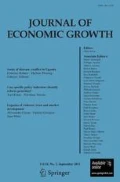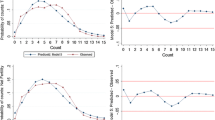Abstract
This paper analyzes qualitatively and quantitatively the effects of declining mortality rates on fertility, education and economic growth. The analysis demonstrates that if individuals are prudent in the face of uncertainty about child survival, a decline in an exogenous mortality rate reduces precautionary demand for children and increases parental investment in each child. Once mortality is endogenized, population growth becomes a hump-shaped function of income per capita. At low levels of income population growth rises as income per capita rises leading to a Malthusian steady-state equilibrium, whereas at high levels of income population growth declines leading to a sustained growth steady-state equilibrium.
Similar content being viewed by others
References
Becker, G. S. (1981). “Altruism in the Family and Selfishness in the Market Place,” Economica 48, 1–15.
Becker, G. S., and R. J. Barro. (1988). “A Reformulation of the Economic Theory of Fertility,” Quarterly Journal of Economics 103, 1–25.
Becker, G. S., K. M. Murphy, and T. Robert. (1990). “Human Capital, Fertility and Economic Growth,” Journal of Political Economy 98, 12–37.
Ben-Porath, Y. (1976). “Fertility Response to Child Mortality: Micro Data from Israel,” Journal of Political Economy 84, 163–178.
Bongaarts, J. (1999). “Fertility Decline in the Developed World: Where Will It End?” American Economic Review (Papers and Proceedings) 89, 256–260.
Brezis, S. E. (2001). “Social Classes, Demographic Transition and Economic Growth,” European Economic Review 45, 701–717.
Cain, M. (1977). “The Economic Activities of Children in a Village in Bangladesh,” Population and Development Review 3, 201–227.
Caldwell, J. (1976). “Toward a Restatement of Demographic Transition Theory,” Population and Development Review 2, 321–366.
Clark, C. (1970). Population Growth and Land Use. London: Macmillan Press.
Coale, A. J. (1986). “The Decline of Fertility in Europe since the Eighteenth Century as a Chapter in Human Demographic History.” In A. J. Coale and S. C. Watkins (eds), The Decline of Fertility in Europe: The Revised Proceedings of a Conference on the Princeton European Fertility Project. Princeton: Princeton University Press.
Dahan, M., and D. Tsiddon. (1998). “Demographic Transition, Income Distribution, and Economic Growth,” Journal of Economic Growth 3, 29–51.
Dyson, T., and M. Murphy. (1985). “The Onset of Fertility Transition,” Population and Development Review 11, 399–439.
Eckstein, Z., P. Mira, and K. I. Wolpin. (1998). “A Quantitative Analysis of Swedish Fertility Dynamics: 1751–1990.” CEPR Discussion Paper 1832.
Ehrlich, I., and F. T. Lui. (1991). “Intergenerational Trade, Longevity, Intrafamily Transfers and Economic Growth,” Journal of Political Economy 99, 1029–1059.
Galloway, P. R., R. D. Lee, and E. A. Hummel. (1998). “Infant Mortality and the Fertility Transition: Macro Evidence from Europe and New Findings from Prussia,” In B. Cohen and M. R. Montgomery (eds), From Death to Birth: Mortality Decline and Reproductive Change. Washington: National Academy Press.
Galor, O., and O. Moav. (2002). “Natural Selection and the Origin of Economic Growth,” Quarterly Journal of Economics, 117, 1133–1192.
Galor, O., and D. N. Weil. (1996). “The Gender Gap, Fertility, and Growth,” American Economic Review 86, 374–387.
Galor, O., and D. N. Weil. (1999). “From Malthusian Stagnation to Modern Growth,” American Economic Review 89, 150–154.
Galor, O., and D. N. Weil. (2000). “Population, Technology, and Growth: From Malthusian Stagnation to the Demographic Transition and Beyond,” American Economic Review 90, 806–828.
Haines, M. R. (1994). “Estimated Life Tables for the United States, 1850–1900.” NBER Historical Paper 59.
Haines, R. (1998), “The Relationship between Infant and Child Mortality and Fertility: Some Historical and Contemporary Evidence for the United States.” In B. Cohen and M. R. Montgomery (eds.), From Death to Birth: Mortality Decline and Reproductive Change. Washington: National Academy Press.
Hansen, G. D., and E. C. Prescott. (2002). “Malthus to Solow,” American Economic Review. Forthcoming.
Heckman, J. J. (2000). “Policies to Foster Human Capital,” Research in Economics 54, 3–56.
Heckman, J. J., and J. R. Walker. (1990). “The Relationship between Wages and Income and the Timing and Spacing of Births: Evidence from Swedish Longitudinal Data,” Econometrica 58, 1411–1442.
Kaplan, H. (1994). “Evolutionary and Wealth Flows Theories of Fertility: Empirical Tests and New Models,” Population and Development Review 20, 753–791.
Kalemli-Ozcan, S. (2000). Uncertainty and Economic Growth. Ph.D. Dissertation, Brown University.
Kalemli-Ozcan, S. (2002). “A Stochastic Model of Mortality, Fertility and Human Capital Investment,” Journal of Development Economics, forthcoming.
Keyfitz, N., and W. Flieger. (1968). World Population: An Analysis of Vital Data. Chicago: The University of Chicago Press.
Keyfitz, N., and W. Flieger. (1990). World Population Growth and Aging. Chicago: The University of Chicago Press.
Keyfitz, N., S. H. Preston, and R. Schoen. (1972). Causes of Death: Life Tables for National Populations. New York: Seminar Press.
Kimball, M. S. (1990). “Precautionary Saving in the Small and in the Large,” Econometrica 58, 53–73.
Kogel T., and A. Prskawetz. (2001). “Agricultural Productivity Growth and Escape from the Malthusian Trap,” Journal of Economic Growth 6, 337–357.
Kremer, M. (1993). “Population Growth and Technological Change: One Million B.C. to 1990,” Quarterly Journal of Economics 108, 681–716.
Lagerlof, N. P. (2002). “From Malthus to Modern Growth: Can Epidemics Explain the Three Regimes?” International Economic Review, forthcoming.
Lesthaeghe R., and E. Van de Walle. (1976). “Economic Factors and Fertility Decline in France and Belgium.” In A. J. Coale (ed.), Economic Factors in Population Growth. New York: John Wiley and Sons.
Livi-Bacci, M. (1997). A Concise History of World Population. Oxford: Blackwell.
Lucas, R. E. (2002). Lectures on Economic Growth. Cambridge: Harvard.
Maddison, A. (1995). Monitoring the World Economy 1820–1992. Paris: OECD
Matthews, R. C. O., C. H. Feinstein, and J. C. Odling-Smee. (1982). British Economic Growth, 1856–1973. Stanford: Stanford University Press.
McDermott, J. (2002). “Development Dynamics: Economic Integration and Demographic Transition,” Journal of Economic Growth 7, 375–413.
Meltzer, D. (1992). “Mortality Decline, the Demographic Transition and Economic Growth,” Ph.D Dissertation, University of Chicago.
Morand, O. (2002). “Evolution through Revolutions: Growing Populations and Changes in Modes of Production.” Mimeo, University of Connecticut.
Mroz, A. T., and D. R. Weir. (1990). “Structural Change in Life Cycle Fertility during the Fertility Transition: France before and after the Revolution of 1789,” Population Studies 44, 61–87.
O'Hara, D. J. (1975), “Microeconomic Aspects of the Demographic Transition,” Journal of Political Economy 83, 1203–1216.
Parente S. L., and E. C. Prescott. (2000). Barriers to Riches. Cambridge: MIT Press.
Portner C. (2001), “Children as Insurance,” Journal of Population Economics 14, 119–136.
Preston, S. H. (1978a). “The Changing Relation between Mortality and Economic Development,” Population Studies 29, 231–248.
Preston, S. H. (1978b). The Effects of Infant and Child Mortality on Fertility. New York: Academic Press.
Ram, R., T. Schultz. (1979). “Life Span, Health, Savings and Productivity,” Economic Development and Cultural Change 13, 399–421.
Sah, R. K. (1991). “The Effects of Child Mortality Changes on Fertility Choice and Parental Welfare,” Journal of Political Economy 99, 582–606.
Schultz, P. T. (1985). “Changing World Prices, Women's Wages, and the Fertility Transition: Sweden 1860–1910,” Journal of Political Economy 93, 1126–1154.
Schultz, P. T. (1997). “Demand for Children in Low Income Countries.” In M. R. Rosenzweig and O. Stark (eds), Handbook of Population and Family Economics. Amsterdam: Elsevier Science.
Segalen, M. (1992). “Exploring a Case of Late French Fertility Decline: Two Contrasted Breton Examples.” In J. R. Gillis, L. A. Tilly and D. Levine (eds), The European Experience of Declining Fertility, 1850–1970. Cambridge: Blackwell.
Tamura, R. (2002). “Human Capital and Economic Development.” Mimeo, Clemson University.
United Nations Population Division. (1999). Demographic Indicators 1950–2050.
Weil, D. N. (2001). Economic Growth. Addison-Wesley, forthcoming.
Wolpin, K. I. (1997). “Determinants and Consequences of the Mortality and Health of Infants and Children.” In M. R. Rosenzweig and O. Stark (eds), Handbook of Population and Family Economics, Volume 1A. Amsterdam: Elsevier Science.
World Bank. (2000). World Development Indicators 2000.
Wrigley, E. A., and R. S. Schofield. (1981). The Population History of England 1541–1871: A Reconstruction. Cambridge: Harvard University Press
Author information
Authors and Affiliations
Rights and permissions
About this article
Cite this article
Kalemli-Ozcan, S. Does the Mortality Decline Promote Economic Growth?. Journal of Economic Growth 7, 411–439 (2002). https://doi.org/10.1023/A:1020831902045
Issue Date:
DOI: https://doi.org/10.1023/A:1020831902045




